6 top tips for learning to ski powder
With so many skiers and snowboarders enthusiastically proclaiming the joy of powder riding, it is natural that our curiosity may be piqued along with an interest to give it a try. As with many good things in life though, it takes a little direction, time and practise – but is so worth the energy put in. To give you a nudge in the right direction here are our 6 top tips for getting started in powder.
 1. Right tools for the job
This may seem obvious but by being on condition appropriate equipment is really important. People often get this wrong by using skis that are much wider than the conditions call for, or not wide enough. For a few centimetres of fresh snow it is not necessary – and indeed not advised – to clip on the biggest powder skis on the market, especially if you are accustomed to piste skis. Sprinklings of fresh snow becomes skier compacted very quickly, and you could end up spending most of the day learning to manoeuvre the skis on what slopes that are more piste than powder. You may initially find engaging an edge harder and turning more clumsy. By contrast, when there is a large amount of fresh snow – let’s say more than 15 centimetres – wider skis will provide a larger surface area, helping to keep the tips above snow and making it much easier than a narrower pair that would be liable to bury themselves and make us work much harder than we need. In short, there are days for enormous powder skis, but also many days when a good pair of all mountain skis would do the job better; assess the conditions before choosing your weapons.
1. Right tools for the job
This may seem obvious but by being on condition appropriate equipment is really important. People often get this wrong by using skis that are much wider than the conditions call for, or not wide enough. For a few centimetres of fresh snow it is not necessary – and indeed not advised – to clip on the biggest powder skis on the market, especially if you are accustomed to piste skis. Sprinklings of fresh snow becomes skier compacted very quickly, and you could end up spending most of the day learning to manoeuvre the skis on what slopes that are more piste than powder. You may initially find engaging an edge harder and turning more clumsy. By contrast, when there is a large amount of fresh snow – let’s say more than 15 centimetres – wider skis will provide a larger surface area, helping to keep the tips above snow and making it much easier than a narrower pair that would be liable to bury themselves and make us work much harder than we need. In short, there are days for enormous powder skis, but also many days when a good pair of all mountain skis would do the job better; assess the conditions before choosing your weapons.
 2. Leave your pride behind
At the risk of sounding ambitiously idealistic, relax and have fun. Whether we like it or not, learning to powder ski is not the time to showcase our most polished selves. We can expect a few, if not many, stacks and tumbles. The good news though is that powder is just that; powdery, light and and most importantly soft. It is the perfect landing for your most undignified crash; it can also provide ample entertainment to friends, family or members of the public riding the lift above you. In truth it is important that we accept we will take spill or two and don’t take ourselves too seriously; otherwise it is easy to become frustrated or overwhelmed. And if you need another incentive to try and have fun with it, our bodies are far more likely to sustain injury when they are ridged and tense than when they are relaxed and at ease.
2. Leave your pride behind
At the risk of sounding ambitiously idealistic, relax and have fun. Whether we like it or not, learning to powder ski is not the time to showcase our most polished selves. We can expect a few, if not many, stacks and tumbles. The good news though is that powder is just that; powdery, light and and most importantly soft. It is the perfect landing for your most undignified crash; it can also provide ample entertainment to friends, family or members of the public riding the lift above you. In truth it is important that we accept we will take spill or two and don’t take ourselves too seriously; otherwise it is easy to become frustrated or overwhelmed. And if you need another incentive to try and have fun with it, our bodies are far more likely to sustain injury when they are ridged and tense than when they are relaxed and at ease.
 3. Adjust your stance
In terms of technique, the first thing to adjust is our stance. While a hip width stance on groomers makes perfect sense, it is advantageous while we are learning to ski powder that we bring our feet a little closer together. This will decrease the likelihood of our outside ski `getting away from us` during our turn, a common mishap in which it either sinks or peels off In a different direction from the other.
3. Adjust your stance
In terms of technique, the first thing to adjust is our stance. While a hip width stance on groomers makes perfect sense, it is advantageous while we are learning to ski powder that we bring our feet a little closer together. This will decrease the likelihood of our outside ski `getting away from us` during our turn, a common mishap in which it either sinks or peels off In a different direction from the other.
 4. Get even
Deep snow can grab our skis and make it feel as if we can`t steer them; in truth we can once proficient and technically correct, but while we are learning this is often the case. The trick at this stage is to try to weight our skis somewhat evenly with one another in a bid to avoid sinking one; namely the outside one. Piste skiing has taught us to rely more on the lower and outside ski, but if we did that in deep snow we would most likely bury, stop or even loose our outside ski, while the inside one continued moving with ease through the snow. As you can image, not the best result. A good to way to distribute our weight more evenly is to try little hops or jumps for a few turns each time you set off.
4. Get even
Deep snow can grab our skis and make it feel as if we can`t steer them; in truth we can once proficient and technically correct, but while we are learning this is often the case. The trick at this stage is to try to weight our skis somewhat evenly with one another in a bid to avoid sinking one; namely the outside one. Piste skiing has taught us to rely more on the lower and outside ski, but if we did that in deep snow we would most likely bury, stop or even loose our outside ski, while the inside one continued moving with ease through the snow. As you can image, not the best result. A good to way to distribute our weight more evenly is to try little hops or jumps for a few turns each time you set off.
 5. Tweak your turns
Another thing we can do to promote both a closer stance and more even weight distribution is to adjust the shape of our turns. Therefore, while learning powder try to make smaller turns with less travel across the slope, and instead work on keeping your body facing downwards. Being in deep snow allows your skis more time to face down the slope than on the piste as the powder is providing friction and resistance. In turn, it is easier to keep your body facing downhill. A good way to do this is to focus on something at the bottom of the slope – a building for example – and drawn an invisible line between it and the centre of your chest. As you ski down try to keep from turning your body across the slope too much by trying to keep the invisible line uninterrupted.
5. Tweak your turns
Another thing we can do to promote both a closer stance and more even weight distribution is to adjust the shape of our turns. Therefore, while learning powder try to make smaller turns with less travel across the slope, and instead work on keeping your body facing downwards. Being in deep snow allows your skis more time to face down the slope than on the piste as the powder is providing friction and resistance. In turn, it is easier to keep your body facing downhill. A good way to do this is to focus on something at the bottom of the slope – a building for example – and drawn an invisible line between it and the centre of your chest. As you ski down try to keep from turning your body across the slope too much by trying to keep the invisible line uninterrupted.
 6. Invest in a lesson
The most effective way to learn to ski powder is by taking a lesson from a professional. As people who teach it daily, instructors know the common problems and pit falls and therefore how to avoid them. It is also a good idea to have someone very capable with you in deep snow, to develop your skills, share some of the physical load (think boot-packing back uphill to retrieve a buried ski), and most importantly ensure your safety in what can be hazardous conditions when unprepared. This is the fastest and surest way to learn, and probably the most fun too!
Nadine Robb is Owner and Instructor at Hakuba Ski Concierge. Hakuba Ski Concierge is a boutique ski school in Hakuba, Japan.
If you would like to be a guest blogger on A Luxury Travel Blog in order to raise your profile, please contact us.
6. Invest in a lesson
The most effective way to learn to ski powder is by taking a lesson from a professional. As people who teach it daily, instructors know the common problems and pit falls and therefore how to avoid them. It is also a good idea to have someone very capable with you in deep snow, to develop your skills, share some of the physical load (think boot-packing back uphill to retrieve a buried ski), and most importantly ensure your safety in what can be hazardous conditions when unprepared. This is the fastest and surest way to learn, and probably the most fun too!
Nadine Robb is Owner and Instructor at Hakuba Ski Concierge. Hakuba Ski Concierge is a boutique ski school in Hakuba, Japan.
If you would like to be a guest blogger on A Luxury Travel Blog in order to raise your profile, please contact us.
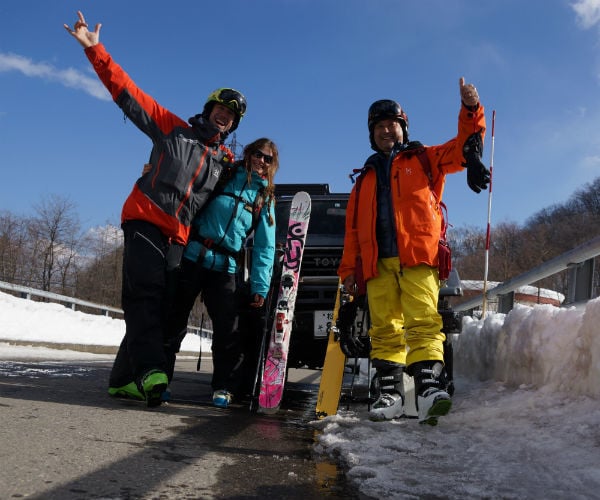 1. Right tools for the job
This may seem obvious but by being on condition appropriate equipment is really important. People often get this wrong by using skis that are much wider than the conditions call for, or not wide enough. For a few centimetres of fresh snow it is not necessary – and indeed not advised – to clip on the biggest powder skis on the market, especially if you are accustomed to piste skis. Sprinklings of fresh snow becomes skier compacted very quickly, and you could end up spending most of the day learning to manoeuvre the skis on what slopes that are more piste than powder. You may initially find engaging an edge harder and turning more clumsy. By contrast, when there is a large amount of fresh snow – let’s say more than 15 centimetres – wider skis will provide a larger surface area, helping to keep the tips above snow and making it much easier than a narrower pair that would be liable to bury themselves and make us work much harder than we need. In short, there are days for enormous powder skis, but also many days when a good pair of all mountain skis would do the job better; assess the conditions before choosing your weapons.
1. Right tools for the job
This may seem obvious but by being on condition appropriate equipment is really important. People often get this wrong by using skis that are much wider than the conditions call for, or not wide enough. For a few centimetres of fresh snow it is not necessary – and indeed not advised – to clip on the biggest powder skis on the market, especially if you are accustomed to piste skis. Sprinklings of fresh snow becomes skier compacted very quickly, and you could end up spending most of the day learning to manoeuvre the skis on what slopes that are more piste than powder. You may initially find engaging an edge harder and turning more clumsy. By contrast, when there is a large amount of fresh snow – let’s say more than 15 centimetres – wider skis will provide a larger surface area, helping to keep the tips above snow and making it much easier than a narrower pair that would be liable to bury themselves and make us work much harder than we need. In short, there are days for enormous powder skis, but also many days when a good pair of all mountain skis would do the job better; assess the conditions before choosing your weapons.
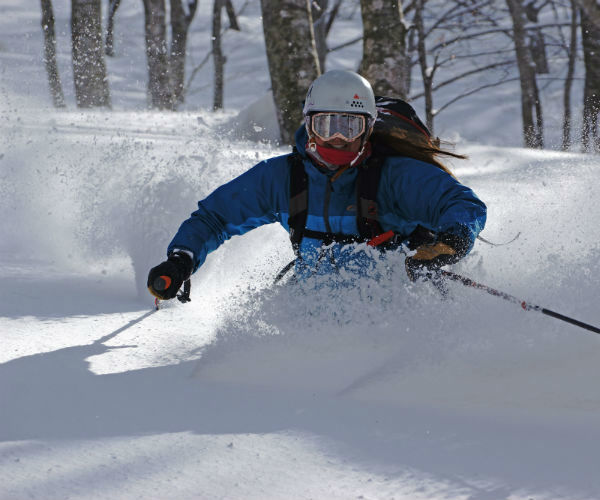 2. Leave your pride behind
At the risk of sounding ambitiously idealistic, relax and have fun. Whether we like it or not, learning to powder ski is not the time to showcase our most polished selves. We can expect a few, if not many, stacks and tumbles. The good news though is that powder is just that; powdery, light and and most importantly soft. It is the perfect landing for your most undignified crash; it can also provide ample entertainment to friends, family or members of the public riding the lift above you. In truth it is important that we accept we will take spill or two and don’t take ourselves too seriously; otherwise it is easy to become frustrated or overwhelmed. And if you need another incentive to try and have fun with it, our bodies are far more likely to sustain injury when they are ridged and tense than when they are relaxed and at ease.
2. Leave your pride behind
At the risk of sounding ambitiously idealistic, relax and have fun. Whether we like it or not, learning to powder ski is not the time to showcase our most polished selves. We can expect a few, if not many, stacks and tumbles. The good news though is that powder is just that; powdery, light and and most importantly soft. It is the perfect landing for your most undignified crash; it can also provide ample entertainment to friends, family or members of the public riding the lift above you. In truth it is important that we accept we will take spill or two and don’t take ourselves too seriously; otherwise it is easy to become frustrated or overwhelmed. And if you need another incentive to try and have fun with it, our bodies are far more likely to sustain injury when they are ridged and tense than when they are relaxed and at ease.
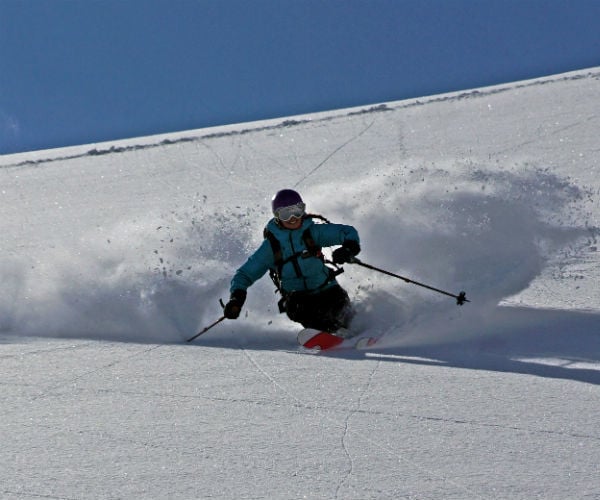 3. Adjust your stance
In terms of technique, the first thing to adjust is our stance. While a hip width stance on groomers makes perfect sense, it is advantageous while we are learning to ski powder that we bring our feet a little closer together. This will decrease the likelihood of our outside ski `getting away from us` during our turn, a common mishap in which it either sinks or peels off In a different direction from the other.
3. Adjust your stance
In terms of technique, the first thing to adjust is our stance. While a hip width stance on groomers makes perfect sense, it is advantageous while we are learning to ski powder that we bring our feet a little closer together. This will decrease the likelihood of our outside ski `getting away from us` during our turn, a common mishap in which it either sinks or peels off In a different direction from the other.
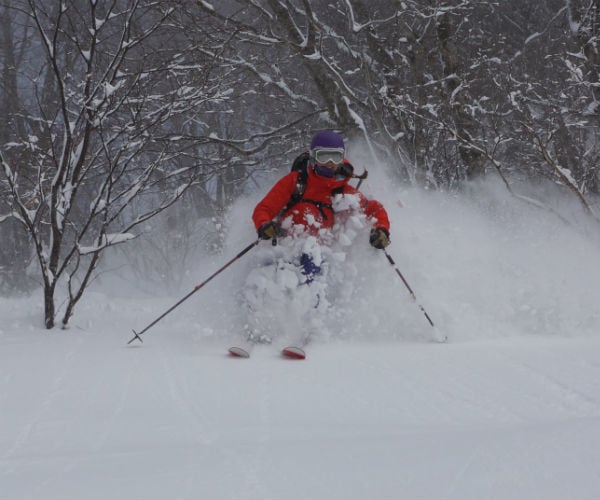 4. Get even
Deep snow can grab our skis and make it feel as if we can`t steer them; in truth we can once proficient and technically correct, but while we are learning this is often the case. The trick at this stage is to try to weight our skis somewhat evenly with one another in a bid to avoid sinking one; namely the outside one. Piste skiing has taught us to rely more on the lower and outside ski, but if we did that in deep snow we would most likely bury, stop or even loose our outside ski, while the inside one continued moving with ease through the snow. As you can image, not the best result. A good to way to distribute our weight more evenly is to try little hops or jumps for a few turns each time you set off.
4. Get even
Deep snow can grab our skis and make it feel as if we can`t steer them; in truth we can once proficient and technically correct, but while we are learning this is often the case. The trick at this stage is to try to weight our skis somewhat evenly with one another in a bid to avoid sinking one; namely the outside one. Piste skiing has taught us to rely more on the lower and outside ski, but if we did that in deep snow we would most likely bury, stop or even loose our outside ski, while the inside one continued moving with ease through the snow. As you can image, not the best result. A good to way to distribute our weight more evenly is to try little hops or jumps for a few turns each time you set off.
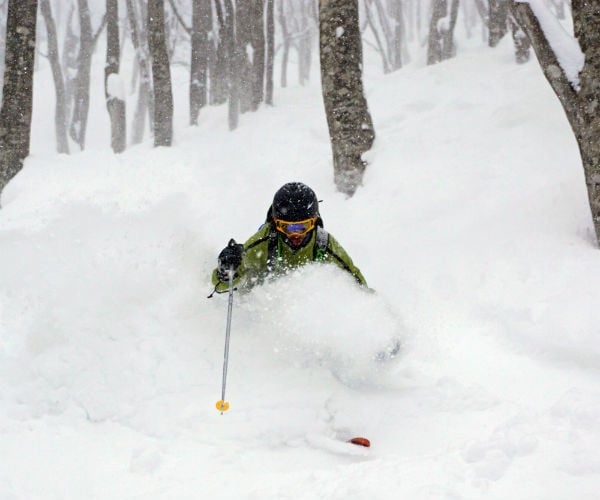 5. Tweak your turns
Another thing we can do to promote both a closer stance and more even weight distribution is to adjust the shape of our turns. Therefore, while learning powder try to make smaller turns with less travel across the slope, and instead work on keeping your body facing downwards. Being in deep snow allows your skis more time to face down the slope than on the piste as the powder is providing friction and resistance. In turn, it is easier to keep your body facing downhill. A good way to do this is to focus on something at the bottom of the slope – a building for example – and drawn an invisible line between it and the centre of your chest. As you ski down try to keep from turning your body across the slope too much by trying to keep the invisible line uninterrupted.
5. Tweak your turns
Another thing we can do to promote both a closer stance and more even weight distribution is to adjust the shape of our turns. Therefore, while learning powder try to make smaller turns with less travel across the slope, and instead work on keeping your body facing downwards. Being in deep snow allows your skis more time to face down the slope than on the piste as the powder is providing friction and resistance. In turn, it is easier to keep your body facing downhill. A good way to do this is to focus on something at the bottom of the slope – a building for example – and drawn an invisible line between it and the centre of your chest. As you ski down try to keep from turning your body across the slope too much by trying to keep the invisible line uninterrupted.
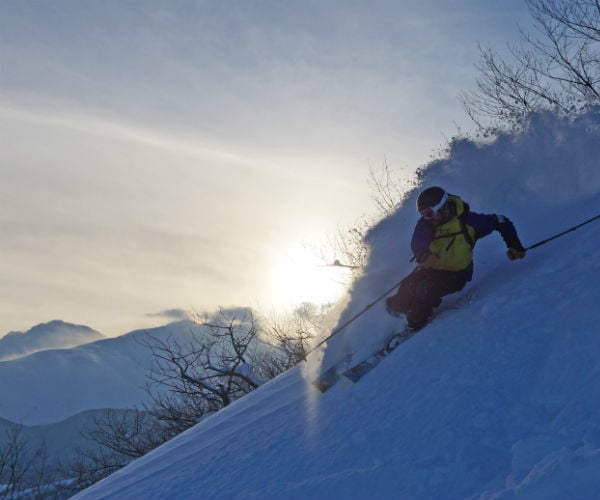 6. Invest in a lesson
The most effective way to learn to ski powder is by taking a lesson from a professional. As people who teach it daily, instructors know the common problems and pit falls and therefore how to avoid them. It is also a good idea to have someone very capable with you in deep snow, to develop your skills, share some of the physical load (think boot-packing back uphill to retrieve a buried ski), and most importantly ensure your safety in what can be hazardous conditions when unprepared. This is the fastest and surest way to learn, and probably the most fun too!
Nadine Robb is Owner and Instructor at Hakuba Ski Concierge. Hakuba Ski Concierge is a boutique ski school in Hakuba, Japan.
If you would like to be a guest blogger on A Luxury Travel Blog in order to raise your profile, please contact us.
6. Invest in a lesson
The most effective way to learn to ski powder is by taking a lesson from a professional. As people who teach it daily, instructors know the common problems and pit falls and therefore how to avoid them. It is also a good idea to have someone very capable with you in deep snow, to develop your skills, share some of the physical load (think boot-packing back uphill to retrieve a buried ski), and most importantly ensure your safety in what can be hazardous conditions when unprepared. This is the fastest and surest way to learn, and probably the most fun too!
Nadine Robb is Owner and Instructor at Hakuba Ski Concierge. Hakuba Ski Concierge is a boutique ski school in Hakuba, Japan.
If you would like to be a guest blogger on A Luxury Travel Blog in order to raise your profile, please contact us.Did you enjoy this article?
Receive similar content direct to your inbox.


“Leave your pride behind.” Wise words. They could apply to learning so many things. I know that as an adult it can be hard to follow this motto but it is the only way to learn. Falling and failing are all part of skiing. You’ve just got to dust your self off and start over again.
Actually having the right tools for the job is another great piece of advice for life.
That is exactly right Helen, to brush yourself off and start over again. Thank you for your comment!
Very tempting and you give loads of advice. Maybe too much for me to take in.
So the last tip – invest in a lesson with a pro is probably the one I’d go with first.
Well after getting the right gear obviously.
Thank you for your comment Piers; yes there is rather a lot in there. I usually find it best to take just one idea at a time, think and work on it until it is `clicking` and then move on to another. And, as you say, go with a pro!!
After a few years off from skiing due to what seemed like a never ending catalogue of injury and illness I can feel my mojo coming back. I am desperate to get back on the slopes and I feel that I’m going to have to follow all your tips to make sure that I can keep skiing.
I am delighted to hear that skiing is `calling out to you` once more. I am sorry to hear about the injuries and illnesses; the biggest piece of advice I can give here is to relax as much as humanly possible. When we are nervous, protective of body parts or apprehensive, we do tend to become rigid and tense – making us far more vulnerable to injury should we fall. Take your time getting your ski legs back – and enjoy! All the best Sharon :)